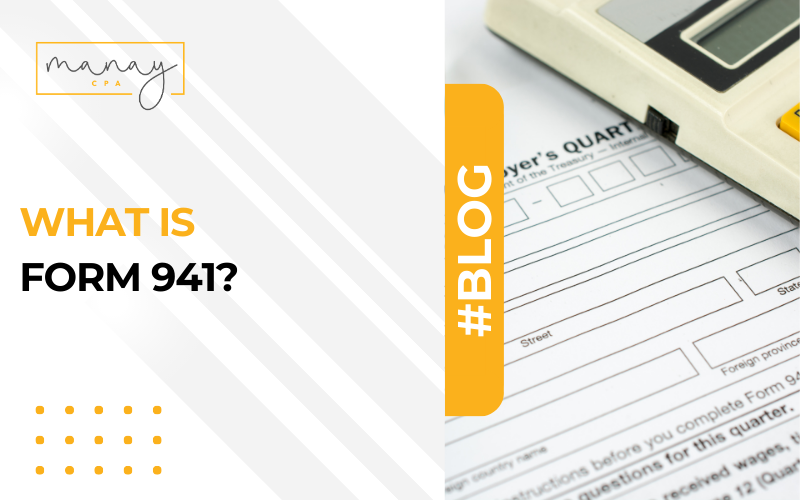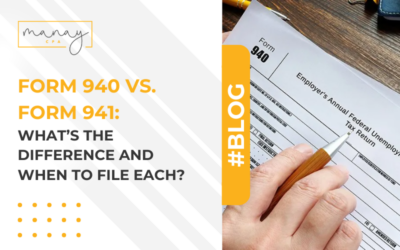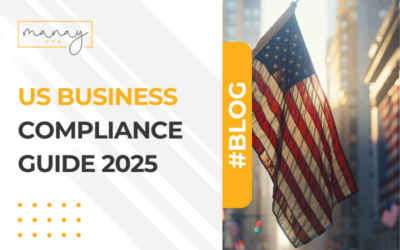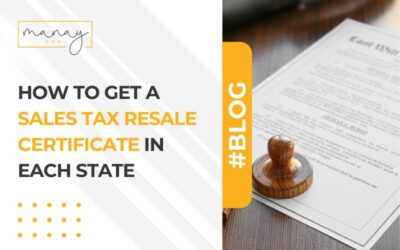What Is Form 941? A Comprehensive Guide to Understanding IRS Tax Form 941

Whether you’re a seasoned business owner or just starting out, understanding Form 941 is crucial to ensuring you’re compliant with the IRS. This form is used to report income taxes, Social Security tax, or Medicare tax withheld from employees’ paychecks and to pay the employer’s portion of Social Security or Medicare tax. But what’s the implication of this for you and your business?
In this guide, we’ll break down Form 941, its purpose, who needs to file it, how to fill it out correctly, how it compares to other IRS forms, a step-by-step guide to completing it, deadlines, penalties, common mistakes to avoid, frequently asked questions, its implications for small businesses, e-filing vs. paper filing, and valuable resources for assistance.
Table of Contents
ToggleThe Basics of Form 941
Before we dive into the details of Form 941, let’s review the basics. Form 941, also called the “Employer’s Quarterly Federal Tax Return,” is used by employers to report income taxes, Social Security tax, and Medicare tax withheld from their employees’ paychecks. It’s also used to report the employer’s share of Social Security and Medicare taxes. As the name suggests, IRS Form 941 must be filed quarterly, which helps provide the IRS with an accurate account of an employer’s tax liabilities.
Why Was Form 941 Introduced?
Form 941 was introduced by the IRS to streamline the process of collecting employment taxes. It ensures that employers accurately withhold income taxes and FICA taxes (Social Security and Medicare) from their employees’ paychecks and also remit their portion of these taxes.
Who Needs to File Form 941?
If you have employees, you’ll likely need to file Form 941. It’s typically required to be filed by employers who pay wages to employees and withhold federal income tax, Social Security tax, or Medicare tax from those wages.
Here are some specific situations where you would need to file Form 941:
- You own a business with employees: If you own a business and have employees on your payroll, you are responsible for withholding federal income tax and FICA taxes from their wages. These details need to be reported on Form 941.
- You are a household employer: If you employ household workers such as nannies, housekeepers, or caretakers, and you pay them more than certain threshold amounts, you may need to file Form 941.
Not all employers need to file Form 941. Some small businesses (those that owe less than $1,000 in annual employment taxes) file Form 944 annually instead of Form 941 quarterly. If you are unsure which tax form your business should file, consult tax professionals
Form 941 vs. Other IRS Forms
When it comes to tax forms, the IRS anticipates the needs of different types of businesses. Here’s how Form 941 compares to other IRS forms.
- Form 941 vs. Form 944: Form 944, is the Employer’s Annual Federal Tax Return, designed for small business owners who owe less than $1,000 in employment taxes for the year. Unlike Form 941, which is filed quarterly, Form 944 is filed annually.
- Form 941 vs. Form 943: Form 943, is the Employer’s Annual Federal Tax Return for Agricultural Employees and is used by agricultural employers to report Social Security and Medicare taxes and withheld income tax for farm workers. It is specifically for agricultural employers.
- Form 941 vs. Form W-2: While Form 941 is used to report taxes withheld from employee wages quarterly, Form W-2 is used to report total annual wages and the amount of taxes withheld from an employee’s paycheck.
- Form 941 vs. Schedule H (Form 1040): Schedule H is used by household employers who pay cash wages to household employees. A household employer wouldn’t need to file Form 941 if all taxes are reported on Schedule H.
Step-by-Step Guide to Completing Form 941
The most convenient way for a business to file the IRS Form 941 is via the Federal e-file system. Alternatively, you could hire tax professionals specializing in small business accounting to handle your business’s tax solutions.
Generally, Form 941 is intuitive and straightforward, with five parts. Here’s a step-by-step guide to completing Form 941.
Part 1: Questions About Your Business For the Quarter
This section lists 15 questions surrounding the tax remitted during the quarter being reported. The questions range from the number of employees who received compensation for their services, federal income tax withheld, and the total deposits for this quarter, including overpayment applied from a prior quarter and overpayments.
Part 2: Your Deposit Schedule and Tax Liability for the Quarter
In this section, you’ll fill in details of your deposit schedule and tax liability for the quarter being reported. This includes your tax liability for each month in the quarter.

Part 3: Details About Your Business
This section queries details specific to your business:
- Whether you’re a seasonal employer, which means you won’t have to file Form 941 every quarter
- Whether your business has ceased operations and no longer paying wages
- The qualified health plan expenses allocable to qualified sick leave wages for leave taken

Part 4: Details of Your Third-Party Designee
If you want the IRS to contact and discuss the filed Form 941 with a third party on your behalf, this is where you enter their contact information. This could be one of your employees or a tax professional.

Part 5: Sign-Off
This is the final section declaring that all the details you’ve provided in the form are true, correct, and complete.


Deadlines and Penalties
It’s important to file Form 941 on time to avoid penalties. These are the deadlines:
- First quarter (January – March): Deadline is April 30
- Second quarter (April – June): Deadline is July 31
- Third quarter (July – September): Deadline is October 31
- Fourth quarter (October – December): Deadline is January 31
If the deadline falls on a weekend or legal holiday, the due date is extended to the next business day.
Note that the IRS imposes penalties for late filing of Form 941, late payment of taxes, and failure to deposit the withheld taxes when they are due. The amount of the penalty depends on how late you are.
Common Mistakes to Avoid
Given the lengthy nature of Form 941, it can be easy to make mistakes if you aren’t thorough. These are some common errors to watch out for:
- Inaccurate reporting of wages and tax liabilities: It’s crucial to accurately report all wages, tips, and other compensation paid to employees. Any discrepancies can lead to audits, penalties, and interest charges.
- Missing deadlines or failing to file altogether: Form 941 must be filed by the last day of the month that follows the end of the quarter.
- Not signing or dating the form: If you submit an unsigned or undated form, the IRS will consider it incomplete.
- Incorrectly categorizing workers as employees or independent contractors: Misclassifying workers can lead to significant penalties and back taxes. Be sure you understand the difference between an employee and an independent contractor.
Remember, if you are unsure of any details in Form 941, you can take advantage of free consultation with tax professionals and streamline your filing.
Form 941 FAQs
What is Form 941 used for?
Form 941 is used by employers to report income taxes, Social Security tax, or Medicare tax withheld from employees’ paychecks and to pay the employer’s portion of Social Security or Medicare tax.
Can I e-file Form 941?
Yes, you can e-file Form 941 through most tax preparation software or a tax professional.
Do I file Form 941 if I have no employees for a particular quarter?
Yes. You must still file a zero return to inform the IRS that you had no tax liability for that quarter.
How do I correct a mistake on a previously filed Form 941?
File Form 941-X, the Adjusted Employer’s Quarterly Federal Tax Return or Claim for Refund, to correct errors.
Form 941 and Your Small Business
As a small business owner, understanding and correctly filing Form 941 is important for the business’s financial health and compliance with IRS regulations. Here are some key points to consider:
Understanding Your Obligations
You’re responsible for withholding federal income tax and FICA taxes from your employee’s wages and depositing them with the IRS. Form 941 helps you achieve this objective every quarter.
Avoiding Penalties
Timely and accurate filing of Form 941 can help you avoid costly penalties and interest charges. We’ve outlined the filing deadlines and requirements in this guide.
Planning for Tax Payments
Since you know when you’re supposed to pay the withheld taxes, regularly setting aside funds for your tax liabilities can help prevent cash flow problems when it’s time to make your quarterly deposits.
Leveraging Technology
As a business owner, you can automate your taxation by using payroll software to automate much of the process of calculating withholdings and preparing Form 941.
Seeking Professional Help
Inarguably, tax laws can be complex and change frequently; contracting services of tax professionals or a part-time CFO goes a long way in ensuring that you’re compliant with the IRS and taking advantage of any applicable tax credits or deductions.
e-Filing vs. Paper Filing
you have two options when it comes to filing Form 941 with the IRS – e-filing or paper filing. While the IRS encourages e-filing for its speed, security, and convenience, your choice of filing method depends on your preferences and business situation. And, both methods have their pros and cons.
| Pros | ✔ Faster processing | ✔ No internet access required |
| ✔ Fewer errors due to built-in checks | ✔ May be preferred by some businesses | |
| ✔ Immediate confirmation of receipt | ✔ Ideal for businesses that prefer having physical records | |
| ✔ Encouraged or required for some businesses | ||
| Cons | ✔ Requires internet access | ✔ Slower processing |
| ✔ May involve setup and registration | ✔ Higher risk of errors in manual calculations | |
| ✔ Potential for technical issues | ✔ No immediate confirmation of receipt |
Resources and Assistance
Whether you’re filing Form 941 for the first time, or you’re accustomed to it, the IRS frequently updates the instructions and requirements on how to file. Here are some resources that can provide assistance:
- IRS instructions for Form 941: The IRS website has comprehensive guides on all forms including Form 941. It also provides FAQs, tax calendars, and other resources.
- Tax Professionals: No one is more up-to-date with all the IRS compliance requirements than tax professionals. More so, they will provide expert guidance tailored to your specific business.
- Tax Software: Many tax software programs offer step-by-step guidance on completing Form 941 and other IRS tax forms.
- Small Business Administration (SBA): The SBA offers resources on understanding your tax obligations as a small business.

Published on: 21 November 2023
Last updated on: 27 July 2024
Manay CPA is a reputable, full-service CPA firm based in Atlanta, Georgia. Founded in 2001, we provide comprehensive accounting and tax solutions to individuals and businesses across all 50 states.





